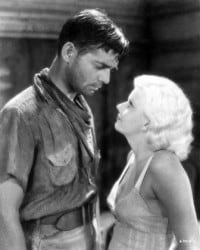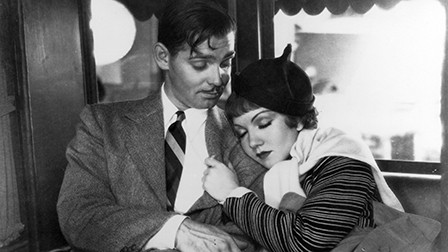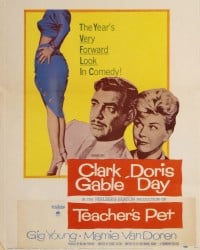These bright comedies provide some harmless laughs in the twilight of the career of “The King of Hollywood.”
Two years, 1958 and 1959. Two films, Teacher’s Pet and But Not for Me. Two actresses, Doris Day and Carroll Baker. A third actress, Lilli Palmer, in the wings. All compete for the affections of one actor, Clark Gable. In these films, the age difference between Gable and his co-stars was nothing new, except in the beginning of his career when his two most frequent screen lovers, Joan Crawford and Jean Harlow, were “only” three and ten years younger, respectively. Even in his most famous film, Gone With the Wind, Vivien Leigh was thirteen years his junior.
 In the 1932 Red Dust, Gable as a rubber plantation owner in French Indochina was romancing both Harlow and Mary Actor. When the film was remade twenty-one years later as Mogambo, much was made of his durability as a screen lover, for he, now fifty-two and a Great White Hunter in Africa, remained. The ladies, however, had been replaced by Ava Gardner and Grace Kelly, both half his age.
In the 1932 Red Dust, Gable as a rubber plantation owner in French Indochina was romancing both Harlow and Mary Actor. When the film was remade twenty-one years later as Mogambo, much was made of his durability as a screen lover, for he, now fifty-two and a Great White Hunter in Africa, remained. The ladies, however, had been replaced by Ava Gardner and Grace Kelly, both half his age.
After Mogambo, the age gap between Gable and the ladies continued, only more ridiculously so. He had grown older while his co-stars were the same ages as before, sometimes even younger. Occasionally, because of the added spread in both age and waistline, the romantic chemistry failed to ignite. Born in 1901, Gable was now starring opposite Susan Hayward in Soldier of Fortune, Jane Russell in The Tall Men (both 1955), Yvonne De Carlo in Band of Angels (1957), Sophia Loren in It Started in Naples (1960) and Marilyn Monroe in The Misfits (1961), his last film.
 In both Teacher’s Pet and But Not for Me, the actor’s fourth- and third-to-last films, the Gable magic still works—and works well—because these are comedies, and his gift for comedy had been well established in It Happened One Night (1934) with Claudette Colbert, born in 1903. Especially in But Not for Me, the age issue with the thirty-year-younger Carroll Baker is part of the plot, even made fun of by Gable’s character, who, in the end, decides she is too young for him—no, more accurately, he is too old for her.
In both Teacher’s Pet and But Not for Me, the actor’s fourth- and third-to-last films, the Gable magic still works—and works well—because these are comedies, and his gift for comedy had been well established in It Happened One Night (1934) with Claudette Colbert, born in 1903. Especially in But Not for Me, the age issue with the thirty-year-younger Carroll Baker is part of the plot, even made fun of by Gable’s character, who, in the end, decides she is too young for him—no, more accurately, he is too old for her.
But bits of plot are slipping in prematurely. . . .
Teacher’s Pet is noticeably better than But Not for Me, mainly because of the strength of Doris Day, whose comic flair, largely and appropriately suppressed somewhat here, would shortly launch a series of famous comedies that would extend her movie career another ten years: It Happened to Jane, Pillow Talk (both 1959), Please Don’t Eat the Daises (1960), That Touch of Mink (1962), Move Over, Darling (1963), Send Me No Flowers (1964) and many others. Her leading men would include Jack Lemmon, David Niven, Cary Grant, James Garner and, most frequently, Rock Hudson.
Even more than Day, the success of Teacher’s Pet belongs to Gig Young as her brainy psychologist boyfriend. In one of his best scenes, Young becomes heavily intoxicated after a drinking contest with Gable at a nightclub when he bragged he could imbibe all he wished without any ill effects. Clearly the best performance in the film, it earned Young an Oscar nomination for Best Supporting Actor.
 Teacher’s Pet begins when journalism professor Erica Stone (Day) asks a city newspaperman, James Gannon (Gable), to speak to her class. In a nasty letter, he turns down her offer. Forced to accept by his managing editor, Gannon arrives in class as a Jim Gallagher, since Erica has never seen Gannon. Despite arriving late, he immediately proceeds to correct her attribution of a quote. Immediately as well, they are on a wrong footing, not to last long, however.
Teacher’s Pet begins when journalism professor Erica Stone (Day) asks a city newspaperman, James Gannon (Gable), to speak to her class. In a nasty letter, he turns down her offer. Forced to accept by his managing editor, Gannon arrives in class as a Jim Gallagher, since Erica has never seen Gannon. Despite arriving late, he immediately proceeds to correct her attribution of a quote. Immediately as well, they are on a wrong footing, not to last long, however.
In his growing relationship with Erica, Gallagher discovers he has to compete with her boyfriend, Dr. Hugo Pine (Young), who succumbs to his first hangover. “To me,” he muses, “journalism is, ah, like a hangover—you can read about it for years, but until you’ve actually experienced it, you have no conception of what it’s really like.”
 And in Erica’s own feelings for this student who shows a knack for journalistic writing, she sees Gallagher’s current girlfriend, a nightclub singer (Mamie Van Doren), not as a threat, but as a source of amusement—at Gallagher’s embarrassment when Peggy sings a gyrating, hip-swinging version of “The Girl Who Invented Rock and Roll.” Read More
And in Erica’s own feelings for this student who shows a knack for journalistic writing, she sees Gallagher’s current girlfriend, a nightclub singer (Mamie Van Doren), not as a threat, but as a source of amusement—at Gallagher’s embarrassment when Peggy sings a gyrating, hip-swinging version of “The Girl Who Invented Rock and Roll.” Read More
